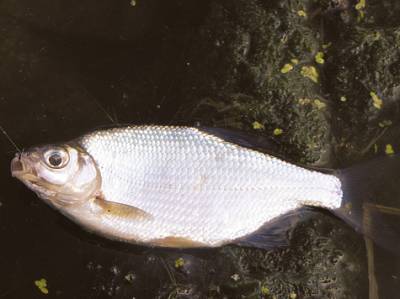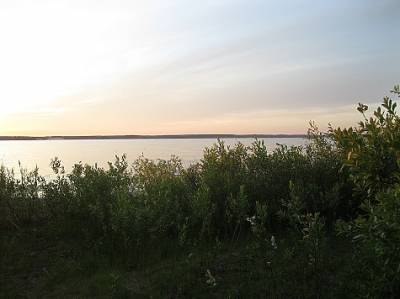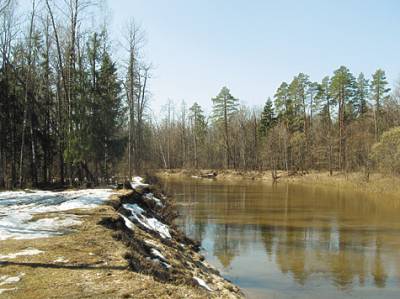
In the spring, when the water level in the rivers is constantly changing and there is a muddy stream, fish on the river is going at certain points. The ability to calculate the time to choose the right equipment and the nozzle ensure a good trophy. More suited for these purposes the so-called Bologna tackle. With her on the spring river you can successfully fish in different periods of the flood.
During the floods the fisherman need to pay attention to the search is not too fast, but relatively clean sections of the river where a lot of natural food and the fish where he goes easily, as though on the go.
Spring fishing can be divided into three periods: the first when the water arrives, the second when the level varies (decreases, increases), and the third when the water level drops. The flood may end earlier or later, it all depends on the size of the river. In the small tributaries it ends sooner large later. Sometimes the level above the zero level is kept in a large river (e.g., Oka) to mid-may and sometimes until mid-June. This is due to the fact that in the spring the water level in the river responds quickly to rainfall and air temperature. So if I set a protracted hot weather, the soil thaws quickly, giving a sharp inflow of water even low tide. Frequent torrential rains, respectively, will also add water.
IN CROWDED PLACES
In a good spring places the fish zhiruet a long time or a short time depending on how quickly the recession of water in the main river. If it goes fast, and the fish, left on meadows, in clean bays and other special places, pecks a day or two, maximum three; if the decline of water goes long the bite lasts up to a week. During the spring the water level fluctuations it is necessary to consider that the fish when lifting closer to the coast, often on the shallow water, and when you are down, slipping into the bed.
In addition to the usual roach, bream, IDE and white bream, in the spring spills on worm and other attachments successfully caught a blue perch, Dace, Chub and goldfish, which, by the way, a lot of the Oka river and most of its tributaries. The fish in this period I’m searching in special places, moving along the shore with Bolognese fishing rod, or waiting for her at once checked sites. But it takes patience: bite, though infrequent, but catches a big fish.
Migratory fish are sometimes collected in large numbers in some spots. For example, some large and small tributaries of the Oka in the spring, I discovered the special places that stood pressed tightly together the different fish. Mostly coveted trophies here has become a major IDE, roach, white bream and bream, and sometimes goldfish. Often a flock of white fish rises in the spill at the mouth of the tributary, in different corners among the flooded bushes and trees or in the other bays, away from the fast jet. Large, clean and not too quick parts search of places where fish is carried out by trial casts. Bait during flood is virtually eliminated. There were times when she stepped up biting the people gathered on the stretch of the roach, white bream and IDE, but these examples belong to the period of catching up to rise of the water when the ice on the river broke, and the muddy water had not yet started.
SPILLS
Usually the spills I use a 6-8-metre Bolognese rod easy to get to the depth of 1-1,5 meters, and float with a short body and long heavy keel, stable in the wind and in Avodah. However, for the most part, is caught here in areas of quiet flow. You can also use weighted, loaded the float with long body, which allows for increased length of fishing line to make a distant casting. Mount float motionless because have to catch at shallow depths. The main line of 0.2–0.23 mm, lead of 0.18–0.2 mm, hook — on attachment. Use thick fishing line for the spring bite is not affected, but saves the toe of the tackle when over the flooded grass, and such hooks happen often. Posting is very slow, close to the ground.
Sometimes, especially at the mouths of tributaries to meet his massive floods, and then a 7-8 foot rod may not be enough. In this case, comes to the rescue Zapadny suit or waders are designed for fishing in cold water. However, note that the bottom in the shallows at high water is viscous.
On the wide spill of white fish is not so tightly grouped as to specific areas of small size. Here it can be found over submerged grass, near shrubs, in some depressions or over mounds on the bottom. Moving their trails for bottling, the fish goes over the earthen ridges, grooves and other relief in the comfort of the seats is delayed. But in the flood the fish is long standing in one place. For example, only in a limited area were the bite of bream, but he went somewhere and came roach and carp. Some experienced anglers ahead of time prokatyvajut in the grass track for the passage of fish, easing himself fishing and given the characteristics of the spring fish migration at high water.
As already noted, in the major tributaries of the Oka welcome spring trophy could be a large goldfish. Local anglers, examining its spring exits to the Sunny shallows, caught here deliberately, autumn mowing down the grass in wide shreds. This takes into account that the prepared place is tyhovoddya ringleader. Catch as regular the Bologna tackle and poludenko that is easy to convert the float rod. To bite was often local apply it two or three rods. However, biting big carp irregular, and need to wait to approach this fish.
ON THE CONTRACTIONS
At low tide or at the beginning and end of the high-level rise a fish often kept under the shore in a very narrow band of middle course, sometimes jumping for food, which blows a quick stream. In such places you can catch in slow transaction or poludenko. Nozzle — depending on the characteristics of the river and phase of the tide. For example, immediately after the ice melts when the Supplement spring the water in the river is small, efficient showerhead will be a bunch of bloodworms, but later the big fish will only tempt the worm.
For fishing on poludenko, converted from Bologna tackle, I seek out areas near grass or shrubs. Successful zones are those for which quiet stream is directed along a coastal cane. It is advisable to find the bottom without snags. Upstream I put the stand under the rod, the heavy float rising to the tip of the fishing rod and throw a snap to the end of the fast jet so that a sinker or a jig with a baited hook with a worm carried on a quieter jet along the reed. Then I put the rod on the stand. You can experiment with the length of the leash, and with a weight shipping and on the basic scaffold, fixing him with a pellet, you can put a sliding sinker “olive” with a weight of 10-15 g.
With the right contact place bites occur when the snap-in is still slow on the demolition. Fishing for demolition requires constant portabrace snap. But you can catch and stationary. To do this, put the rod on the stand, let the bait move from side to side near the bottom on a tight line jet.
IN HOLLOWS, DITCHES AND RAVINES
With the rise of water flooded near the river ravines and small streams cut ravines. And they look like different size bays. They have a lot of flooded bushes, among which it is possible to catch the IDE and roach. Fish comes in here and feeds in a comfortable environment in areas clean, quiet water. In these bays there are to twist the thread, the border of which settles smoothly washed away from the banks of the feed.
Fishing rod for fishing in such places is taken short but depending on a free throw. The rod length is 5.7 m at the same settings snap-in. On the line loaded float is placed one bullet the minimum weight. Due to the lightweight bottom tooling nozzle when casting on tyhovoddya ringleader down gently, allowing the fish to notice it.
On tyhovoddya ringleader, near the flooded bushes and grass in the spring in search of food roam dense flocks bleak. They discourage production from the big fish, because in such places it is necessary to apply a weighted snap-in.
ON THE SMALL TRIBUTARIES
The flood tide of discord. But even if it is a mild, white fish enters the tributaries always. After all, when the water level in the main river rises, the flow back, and for it some for slowing down. Here Mutya slurry deposited, and, of course, the water becomes lighter. And clean water is all fish. But the tributaries drawn to the fact that in them a little warmer, as the water of a smaller volume always warms up in the sun faster than the larger. In addition, here the fields are constantly coming warm spring flows. The peculiarity of the forest rivers is that they remain untroubled, and in this period we can always count on a successful catch.
For fishing on the tributaries is necessary to know precisely the area in which the gathered fish. On some of the open rivers in the middle and upper parts, the long, sometimes muddy, so pack the fish are going to not too long interval (300-800 m), including the mouth. Some odpruzeni rivers of the Rybinsk reservoir white fish rises with the tide is much higher, about 1-2 km above is a quick water.
On the Rybinsk river, such as Sable, Day, Lam ‘ – roach, bream, Zope, IDE bite near the shore. Often they are near the reeds, sedges, inundated shrub, in the first or second edge, where the depth is typically 3-5 m. Therefore, sometimes you have to use a long rod capable of delivering nozzle at 14-18 m.
In this case, it works better in a snap with a sliding float.
Often migratory fish on a little eye-catching bottom selects some particular point, and bites her go, one after another, while casting a meter to the side does nothing. Perhaps there is some sort of twig, snag or hole. It so happens that the fish is on the patch of bare earth, and all around flooded grass. When fishing flooded floodplains always have to watch how well does the float after casting. If he doesn’t get up, then fell on the grass. Perhaps at this point, you’ll have to subtract the descent 5 cm and another 30 cm to add. It happens that on a submarine the bump sticking out just one blade of grass and all fish is hanging around her.
It is necessary to consider the lighting. In bright Sunny weather the fish tries to stay either in the shade of a Bush, or away from the coast, but if the same illumination is wind ripples on the water, the fish are not afraid to go out into the shallow water.
Much of the success of fishing in the flood depends on its strength. On the Oka river in times of low tide when the water can rise only 3-4 m, the most diverse fish holding at the mouth of tributaries. Here, when the water is flowing water get a bait to the riverbed can be difficult. A good catch often remain those who use inflatable boats and catches or short-Bologna rod, or ice rod with a jig. When you select a point of the casting should focus on rokovoy curb inflows, and the boat tied to podtopleny the bushes to avoid being blown over. In flooded mouths of tributaries are memorable catches of white fish, particularly large roach. However, according to the rules of fisheries in many regions of the spring fishing from boats, as well as szabadka prohibited.








